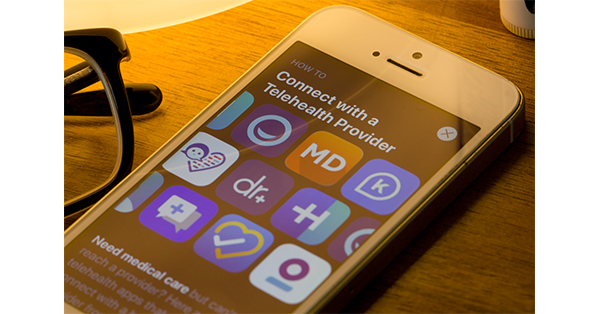– The best resource for monthly healthcare regulatory compliance updates. Compliance Updates: April 2024 Overlook: Licensure Compacts Other Legislation Board Updates Interstate Medical...


In the past, the standard for medical treatment was to arrive at a healthcare facility to be diagnosed and treated. The advancements in technology and COVID-19 have rapidly altered that norm with telehealth becoming the “new norm.”
Telehealth is defined as the delivery of healthcare services at a distance through the use of technology. It can include conducting medical visits over the computer or phone, monitoring patients’ vital signs remotely, communicating via patient portals, and managing and training healthcare staff via video.
The COVID-19 pandemic has accelerated telehealth as policies rapidly changed to meet the demand for remote healthcare services. The influx of telehealth has irreversibly transformed the healthcare landscape and set a new standard of norms to take advantage of a data-rich, electronic environment.
Benefits of Telehealth
The emergence of telehealth offers unprecedented opportunities to improve patient and clinical team outcomes, reduce costs, reach more patients, and impact healthcare quality and accessibility. Telemedicine significantly increases healthcare access for many populations who experience accessibility challenges including:
Telemedicine also streamlines healthcare organizations’ workflows and reduces costs. Payment portals, patient communication tools, and revenue cycle management allow providers to work more closely with patients. In a 2019 study by Jefferson Memorial, leveraging telehealth saved between $19 to $121 per visit and over $1500 when telehealth made the emergency room unnecessary.
Not only did telehealth improve patient care it also impacted administrative finances, specifically in managing provider networks. Savings included credentialing large provider networks and maintaining a compliant roster of providers that meet all regulations.
Telemedicine reduces medical error and prevents unnecessary procedures. Medical error is cited as one of the leading causes of death in the United States. Telehealth and electronic medical records (EMR) can reduce up to 50% of medical errors in healthcare organizations. The reduction of medical errors and the prevention of unnecessary procedures significantly improve patient care and mitigate risk for healthcare institutions such as severe monetary penalties, fines, and disruptions to workflow.
Telehealth Reimbursement
A major linchpin to telehealth adoption has been payment parity. However, insurance payers and Health Care Professional (HCP) associations have supported the transition to telehealth services during the pandemic.
The Centers for Medicare and Medicaid Services (CMS) have recently rolled out an array of regulatory waivers granting payment parity between telehealth and in-person clinical care for Medicare. CMS is also expanding coverage for remote patient monitoring services to address care not necessarily related to the pandemic.
CMS Administrator Seema Verma stated, “Front line healthcare providers need to be able to focus on patient care in the most flexible and innovative ways possible. This unprecedented temporary relaxation in regulation will help the healthcare system deal with patient surges by giving it tools and support to create non-traditional care sites and staff them quickly.”
With providers being able to “bill for telehealth visits at the same rate as in-person visits” and increased flexibility of location-based care, a new precedent has been set for payment parity and telehealth reimbursement. It should be noted, however, that Medicaid programs are administered at the state level and states can choose whether or not to cover telehealth services.
Limitations of Telehealth
Although telehealth offers convenience and lowers costs, there are some major challenges associated with telemedicine. Protecting privacy may become a challenge when dealing with large quantities of data generated by telemedicine. Additionally, accessibility may be a struggle for certain groups as the “digital divide” between age and socioeconomic demographics must be recognized and addressed.
Limitations include (but are not limited to):
Bringing Telehealth to the Next Level
Despite the challenges, the potential for telehealth allows for safer, more effective, more affordable healthcare for a wider array of people. Telemedicine has the potential to create truly personalized healthcare for vulnerable populations, including supporting patients via applications, workflows, and interventions by incorporating remote patient monitoring and identifying social determinants of health (SDOH) to target interventions and improve outcomes.
Telehealth provides the infrastructure to deliver access to specialized care in rural communities and immediate access to healthcare professionals during emergencies. Telehealth also presents opportunities for disease prevention and management, medication management, and rehabilitation.
Telehealth may also allow greater access to patient and clinical data. As regulations change and demand increases, higher numbers of medical staff may work “in” a hospital from a different geographic location.
Hospitals will require more rigorous processes in regard to provider credentialing, license verification, and continuous license and exclusion monitoring and fraud detection to maintain regulatory compliance with the changes that telemedicine brings. As digital healthcare increasingly provides a broader array of opportunities, make sure that your organization is prepared for changes in telemedicine and provider credentialing.
Verisys provides full end-to-end provider credentialing for screening and monitoring your provider population as the telehealth landscape creates more opportunities and reshapes the medical world. Is your organization prepared for the transformative and disruptive age of telehealth? By proactively implementing provider data screening and license verification solutions you can mitigate the inevitable risks in telehealth services and create a safer, higher standard of patient care.
 |
Written by Verisys Verisys transforms provider data, workforce data, and relationship management. Healthcare, life science, and background screening organizations rely on our comprehensive solutions to discover their true potential. Visit verisys.com to learn how we turn problems into power.
|